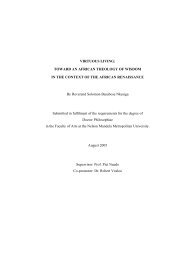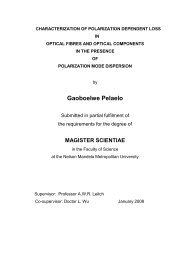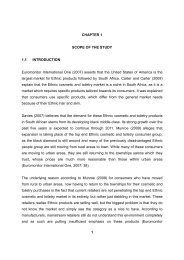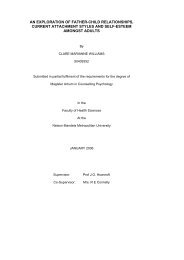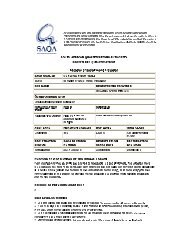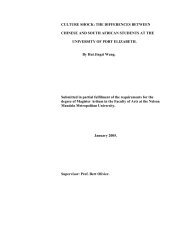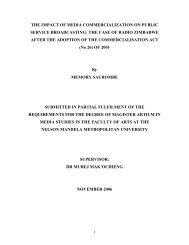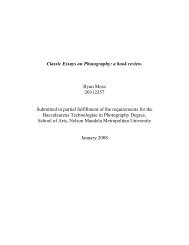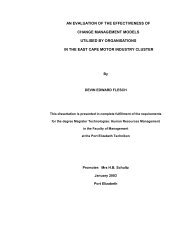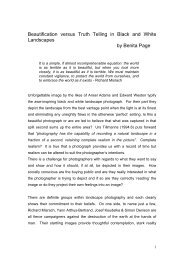an investigation into the antibacterial activities of medicinal plants ...
an investigation into the antibacterial activities of medicinal plants ...
an investigation into the antibacterial activities of medicinal plants ...
You also want an ePaper? Increase the reach of your titles
YUMPU automatically turns print PDFs into web optimized ePapers that Google loves.
methods <strong>of</strong> processing <strong>medicinal</strong> pl<strong>an</strong>ts be taken <strong>into</strong> account when st<strong>an</strong>dardizing<br />
procedures for scientific research. Ethnobot<strong>an</strong>ical information revealed that all <strong>the</strong><br />
pl<strong>an</strong>ts selected in this study are traditionally used fresh for <strong>medicinal</strong> purposes (V<strong>an</strong><br />
Wyk et al., 1997; Rabe & v<strong>an</strong> Staden, 1997; Grierson & Afolay<strong>an</strong>, 1999b).<br />
The incomplete <strong>an</strong>d problematic drying <strong>of</strong> <strong>the</strong> aqueous extract supernat<strong>an</strong>ts in <strong>the</strong><br />
fume-cupboard prompted alternative drying in <strong>an</strong> incubator (37 o C) to obtain a dried<br />
extract residue for <strong>an</strong>alysis (George et al., 2001). Although m<strong>an</strong>y studies report on<br />
using <strong>the</strong> respective solvents for redissolving <strong>the</strong> dried extract residues (Pillay et al.,<br />
2001; El<strong>of</strong>f, 1999), in this study it was found to be problematic, especially with <strong>the</strong><br />
use <strong>of</strong> acetone.<br />
A visual inspection method was used for assessing <strong>the</strong> <strong>an</strong>tibacterial activity <strong>of</strong> pl<strong>an</strong>t<br />
extracts in studies using <strong>the</strong> respective solvents as a redissolving agent (El<strong>of</strong>f, 1999).<br />
However using high concentrations <strong>of</strong> extracts redissolved in acetone interfered with<br />
<strong>the</strong> tr<strong>an</strong>sparency <strong>of</strong> microtitre plates <strong>an</strong>d <strong>the</strong> subsequent spectrophotometric <strong>an</strong>alysis<br />
<strong>of</strong> <strong>the</strong> microtitre plates in this study.<br />
Therefore dimethylsulphoxide (DMSO) was used for redissolving <strong>the</strong> solvent-free<br />
dried pl<strong>an</strong>t extract residues (Harsha et al., 2003; Nostro et al., 2000). The freshly<br />
resuspended acetone <strong>an</strong>d meth<strong>an</strong>ol extracts in DMSO, posed problems with<br />
subsequent spectrophotometric <strong>an</strong>alysis, due to chlorophyll interference <strong>of</strong> <strong>the</strong> dark<br />
coloured extracts. The colour interference was circumvented with <strong>the</strong> preparation <strong>of</strong><br />
a 1.25% solution in distilled water <strong>of</strong> each stock DMSO pl<strong>an</strong>t extract.<br />
The different chemical compositions <strong>of</strong> <strong>the</strong> pl<strong>an</strong>ts may have contributed to <strong>the</strong><br />
processing <strong>of</strong> <strong>medicinal</strong> pl<strong>an</strong>ts <strong>into</strong> fine leave particles. Leaves <strong>of</strong> Meli<strong>an</strong>thus major<br />
followed by Leonotis leonurus produced very fine leave particles in comparison to <strong>the</strong><br />
<strong>of</strong> Z<strong>an</strong>tedeschia aethiopica that did not produce as fine leave particles after crushing<br />
with a pestle <strong>an</strong>d mortar.<br />
The evergreen leaves <strong>of</strong> Z. aethiopica are naturally glossy which contributed to <strong>the</strong><br />
difficulty experienced with crushing <strong>the</strong> leaves <strong>into</strong> fine particles prior to extraction.<br />
The glossy leaves <strong>of</strong> Z. aethiopica, failed to produce fine leave particles after trial<br />
runs using a blender for processing <strong>the</strong> leaves. Pl<strong>an</strong>t material <strong>of</strong> Bulbine frutescens<br />
88



